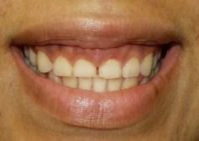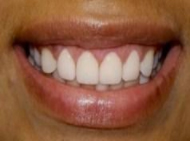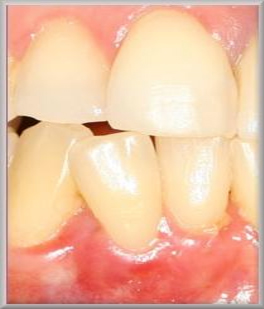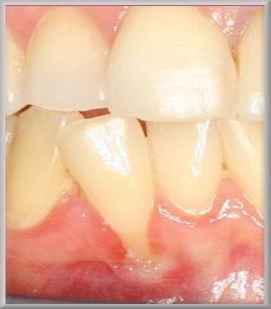PERIODONTAL SERVICES
FUNCTIONAL CROWN LENGTHENING SURGERY
Functional Crown Lengthening is performed when a tooth is decayed or broken below the gum line. The purpose is to create a space between the bone surrounding the broken/decayed tooth and the gum tissue so the tooth/teeth can be properly repaired or restored. Our periodontist gently lifts and rolls back the gum, and re-shapes the gum tissue and sometimes the surrounding bone to expose an adequate amount of healthy tooth.
ESTHETIC CROWN LENGTHENING SURGERY
A beautiful smile shows most of the 8-10 upper teeth with almost no gum above the two front teeth. A smile is considered a “gummy smile” if a significant amount of gingival tissue (gums) can be seen as a person smiles.


Although a gummy smile is considered a normal variation of human anatomy, many people with gummy smiles are very self-conscious when smiling. Fortunately, these smiles can be corrected with simple periodontal surgery procedures.
We can safely modify the position and shape of this gum so that more of your natural enamel and less gum shows when you smile.
This cosmetic procedure improves a “gummy” smile, evens out the gum line, or makes “short” teeth appear longer. With aesthetic crown lengthening surgery, the gum is carefully peeled back to create a “gum flap”. Excess bone and tissue are reshaped to expose more of the natural tooth and/or create a uniform gum line so all your teeth appear to be the same size. Even if only one tooth is involved, our periodontist will also treat the surrounding teeth to ensure a straight, natural smile.
SOFT TISSUE GRAFTS
Exposed tooth roots are the result of gum recession. You may wish to enhance your smile by covering one or more of these roots that make your teeth appear too long. Or, maybe you’re not bothered by the appearance of these areas, but you cringe because the exposed roots are sensitive to hot or cold foods and liquids.


Your gums may have receded for a variety of reasons, including aggressive tooth brushing or periodontal disease. You may not be in control of what caused the recession, but, prior to treatment, we can help you identify the factors contributing to the problem. Once these contributing factors are controlled, a soft tissue graft procedure will repair the defect and help to prevent additional recession and bone loss.
Soft tissue grafts can be used to cover roots or develop gum tissue where absent due to excessive gingival recession. During this procedure, gum tissue is taken from your palate or another donor source to cover the exposed root. This can be done for one tooth or several teeth to even your gum line and reduce sensitivity.
Whether you have soft tissue grafts to improve function or aesthetics, you will receive the benefits of both: a beautiful new smile and improved periodontal health – your keys to smiling, eating and speaking with comfort and confidence.
Contact us immediately and schedule a consultation. You will be taking the first step towards a beautiful smile.
BONE GRAFTS
Gum disease, cavities, injury and infection can all lead to bone loss in the jaw. Dental Bone Grafts or Bone Grafting Surgery is performed to rebuild and regenerate lost dental bone. It helps promote new bone growth and supports the jaw in preparation for implants to restore the appearance and the functionality of your mouth.
The gums are gently folded back and the area is cleaned thoroughly to remove disease-causing bacteria. Isolating and protecting the clean bone area from overlying gum tissue encourages your body’s natural ability to form new bone. Eliminating accumulated bacteria and regenerating living bone will help reduce any pockets that have formed in the surrounding tissue and repair the damage caused by the progression of gum disease.
The purpose of bone grafts is to get your own bone to grow into the repair site. There are a variety of methods to build bone from using bone harvested from the patient’s own body to using donor bone or a synthetic source material. Dental bone grafts and membranes are inserted over the bone defects. Some of these membranes will naturally dissolve over time while others require removal after the healing process is completed.
FRENECTOMY
A frenum is a naturally occurring muscle attachment, normally seen between the front teeth (either upper or lower). It connects the inner aspect of the lip with the gum. A lack of attached gingiva, in conjunction with a high (closer to the biting surface) frenum attachment, which exaggerates the pull on the gum margin, can result in recession. Additionally, an excessively large frenum can prevent the teeth from coming together resulting in a gap between the front teeth. If pulling is seen or the frenum is too large to allow the teeth to come together, the frenum is surgically released from the gum with a frenectomy. A frenectomy is simply the surgical removal of a frenum.
When Orthodontic treatment is planned or initiated, the removal of an abnormal frenum, with or without a gingival graft, can increase stability and improve success of the final orthodontic result.
GUIDED BONE AND TISSUE REGENERATION
Gum disease has traditionally been treated by eliminating the gum pockets by trimming away the infected gum tissue and by re-contouring the uneven bone tissue. Although this is still an effective way of treating gum disease, new and more sophisticated procedures are used routinely today. One of these advancements is guided bone regeneration, also referred to as guided tissue regeneration. This procedure is used to stabilize endangered teeth or to prepare the jaw for dental implants.
As periodontal disease progresses, pockets of degenerated bone develop in the jaw. These pockets can promote the growth of bacteria and the spread of infection. To address these pockets, we may recommend tissue regeneration. During this surgical procedure, the pockets are cleaned thoroughly, and a membrane is installed between the soft tissue and the pocket in the bone. Some of these membranes are bio-absorbable and some require removal. The membrane covers the pocket so that fast-growing soft tissue is blocked, and slower-growing bone can begin to grow, or “regenerate” itself.
The effectiveness of the procedure generally depends on the patient’s willingness to follow a strict postoperative diet and careful oral care. Our periodontist will help you determine if bone regeneration surgery is right for you.
